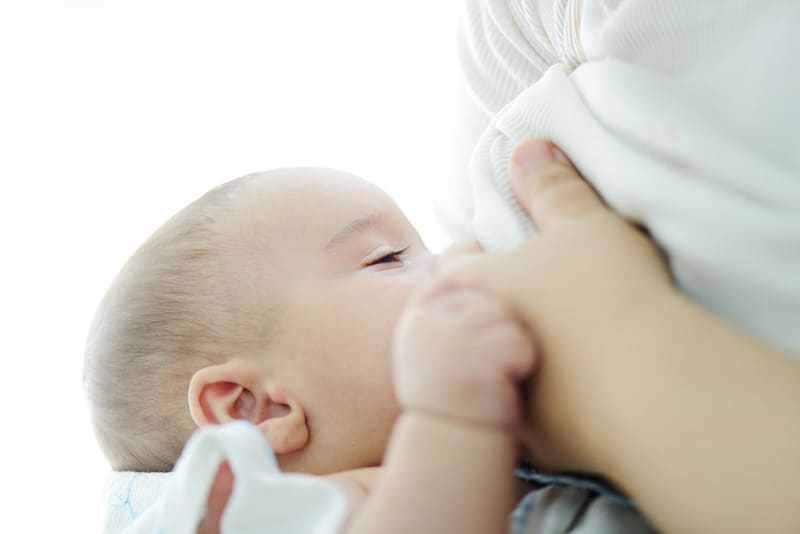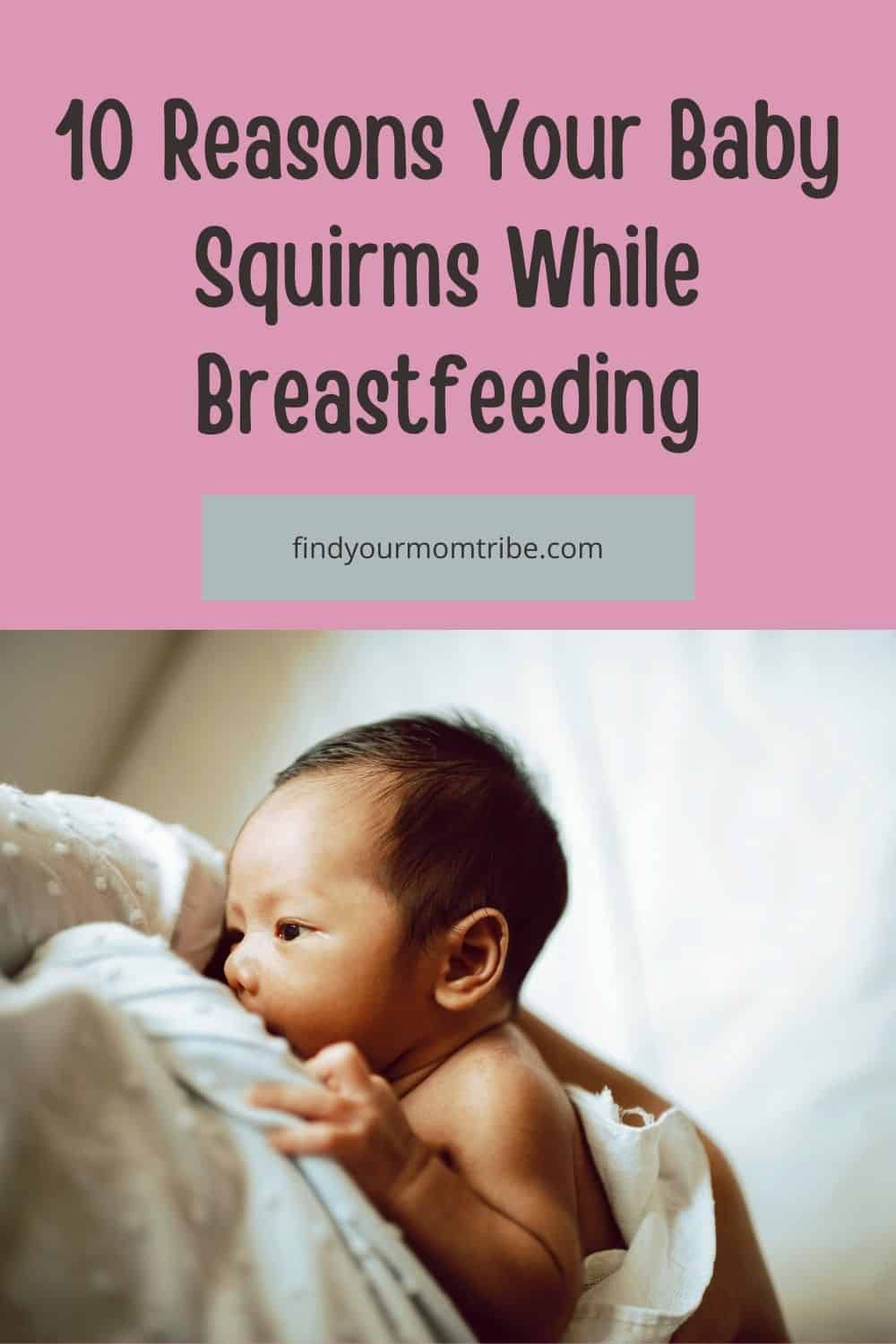Motherhood requires a lot of courage, education, and patience.
It takes a very strong woman to carry her baby to term, feed her, and take responsibility for everything that happens to her.
New mothers often analyze every move their little one makes, so if their baby squirms while breastfeeding most mothers will see it as a cause for concern.
There are various reasons a baby behaves this way, from tiredness to food sensitivity and uncomfortable nursing positions that cause poor latch and a fussy baby.
Of course, not every wiggle is a reason to be worried, but certain mistakes made during the first few months of nursing and other issues related to it may result in problems for both mother and baby.
Some of the most common issues are mastitis, poor milk production, sore nipples, etc.
Read on to discover more about baby squirming while breastfeeding and what you can do to help your baby nurse with ease.
10 Reasons Why Your Baby Squirms While Breastfeeding
Before we get into the details, I should note that squirming is a completely natural reaction that is common among healthy children at certain developmental phases.
However, babies can be fussy during feeding time for various reasons, so let’s take a look at some of the most common ones:
1. Slow let-down reflex

This is one of the most frequent reasons your baby squirms while breastfeeding.
Imagine someone taking away your food just as you started to eat – that’s how babies feel when the milk flow slows down.
Breastfeeding is all about following a particular pattern, which might cause occasional fussiness.
There can be several let-downs during one breastfeeding session, which are then followed by a slow flow of milk.
This can be quite irritating for the baby, so she’ll start fussing to try and get more milk out of the breast.
The baby is actually the one who establishes the breast milk supply and demand by drawing out more milk.
The harder she tries, the more milk you’ll have, which will result in a happier baby who doesn’t squirm during the feeding session.
Squirming is a completely natural reaction when the baby isn’t satisfied with the amount of milk she receives, and it can be easily solved.
For example, you can help your little one by applying pressure to your breast to stimulate the flow of milk, also known as breast compression, and do a gentle massage during breastfeeding.
You’ll notice how calm your little one becomes as soon as she gets enough milk without having to work too hard to get it.
Switching sides during breastfeeding is a good method to reduce squirming as it will increase milk supply in both breasts and your baby will be full and happy!
2. Growth spurt

New parents usually analyze every little detail of their babies, including her movements, crying, and facial expressions.
Growth spurts may cause certain confusion and worries among parents, although these are completely natural processes.
During these periods your little one goes through significant changes, so you might notice some physical alterations in growth or body size and a wider attention span and a curiosity about the world around her.
Your baby might start to squirm even during a feeding session because she can’t concentrate on it completely.
She’ll want to look at everything and react to every voice or noise she hears.
Fussiness isn’t always a sign of something bad, sometimes it’s just about a baby’s curiosity to explore the world around her and a reluctance to breastfeed for a long time.
The best way to prevent your little one from squirming during breastfeeding in these cases is to let your baby feed whenever she wants and for however long she’d like.
This might cause some minor changes to the feeding schedule, but it won’t take too long for the baby to settle into her old schedule again.
3. Tired baby

When a baby starts crying parents immediately start looking for possible causes, mostly because infants never cry without a reason.
The same applies to babies who squirm while being fed – there’s always a reason the baby behaves in such a way.
When babies cry parents try everything, from diaper changing to feeding the little one, but sometimes all they need is some rest.
RELATED: 8 Signs Of An Overtired Baby
If you notice your baby keeps touching her face or rubbing her eyes or her nose, she might not be hungry at all.
If she continues repeating these movements while being fed, it means she’s not really into breast milk and wants to take a nap instead.
You may try to feed your baby to sleep, there’s nothing wrong with that, but only if your baby doesn’t suffer from reflux.
However, some babies are not big fans of being breastfed to sleep and become fussy and upset at the breast.
If the baby keeps rejecting the breast or squirms, it’s time to find another way to help her fall asleep.
4. Breast size

Most mothers notice a certain difference between the left and right breast, especially during the breastfeeding stage.
However, we’re not the only ones who see the difference between them.
Your baby will learn which breast is bigger and fuller, so she might start to reject the smaller one.
If lopsided breasts don’t bother you esthetically, you can just continue using the breast your baby prefers, it won’t do her any harm and she’ll probably fuss far less.
Some mothers try to even them out as much as possible during the breastfeeding period by pumping out the milk after each feeding (in case the baby rejects the smaller-sized breast).
If you’re willing to continue breastfeeding your baby from both sides, you can do so by offering your baby the smaller-sized breast first.
However, if the baby squirms while breastfeeding from the smaller side, it might be better to switch to the fuller breast and pump out the other one or just wean from that breast and continue using the other one.
5. Possible infection or pain

Any type of pain can be a cause of great discomfort for people of all ages. However, adults can talk and express how they feel, but babies can’t, at least not in the typical way.
This is why parents usually analyze every movement of their baby to see any potential signal that something’s not right.
Unfortunately, if the baby squirms while breastfeeding there’s a high chance she’s in pain.
One of the most frequent causes of this is an ear infection.
Lots of babies go through this infection during the infancy period, so it’s no surprise if it happens to your little one as well.
If she suddenly starts squirming every time you feed her on one side, it could be a sign of an ear infection.
Other signs of an ear infection are:
• Pulling ears
• Fever
• Crying
• Difficulty hearing
• Excessive discharge from the ear
• Problems with sleeping
Try switching sides and check which side is causing fussiness. If this behavior repeats every time you feed your child it would be best to call your pediatrician.
6. Uncomfortable position

The nursing position is one of the most important aspects of successful breastfeeding for both mothers and their babies.
Infants already know how to nurse successfully and these “skills” are enhanced by skin-to-skin contact between a mother and her breastfed baby.
However, the baby’s instinct can’t help her to latch on properly, especially if she’s not positioned well.
Most first-time mothers aren’t aware of this positioning issue, which can also cause nipple cracking or soreness, mastitis, and fussiness.
They usually relate these problems to a lack of milk or low-quality breast milk, which is a myth – a mother’s milk fulfills all of the baby’s needs, especially during the first six months of life.
A proper nursing position will enable your little one to eat efficiently and develop in the healthiest way, and will save your nipples too.
There are some general guidelines regarding the right position for nursing, but the key is to make sure both you and the baby feel comfortable.
When latching on your little bundle of joy, make sure that at least an inch of the areola (and not just the nipple) is in the baby’s mouth.
If you notice that your baby is nursing efficiently without wriggling and crying, and that your nipples aren’t sore or cracked – congratulations, you have found the perfect feeding position!
While a newborn baby can’t speak, she can signal when something’s not right by wriggling and squirming, especially during feeding time.
However, if the baby typically nurses without any problems and this type of behavior suddenly begins, there might be another issue at hand, such as a wet diaper, sudden pain, or infection, but this doesn’t mean you should give up on nursing completely.
Many parents switch to bottle-feeding because of common misconceptions about nursing, such as thinking that nipple pain can be resolved only by switching to using a baby bottle, or that a difficult nursing start means the mother won’t be able to breastfeed her child at all.
Of course, a baby bottle is more than acceptable as an occasional replacement for the boob, but if a mother wants and has the ability to breastfeed it’s certainly one of the best choices for her and her little one.
If the latch becomes painful or uncomfortable and your baby squirms while breastfeeding, it’s time to switch positions until you find one that works the best for you and your baby.
However, if you have any worries regarding your breastfeeding baby and the process of nursing in general, you can always speak to a lactation consultant and get a piece of professional advice.
7. Fast let-down reflex

Although a faster flow of breast milk is desirable, it can become too fast, which might result in your baby fussing and wriggling because she can’t breathe properly.
A fast flow of milk might not be a problem for the majority of babies, but there are certain exceptions, especially in the case of a forceful let-down.
An infant can be overwhelmed by an extremely fast let-down, and the best way to recognize this is by noticing how fast your baby swallows milk during the first few minutes of feeding time.
If the baby swallows rapidly and starts squirming, it’s a clear sign the let-down is too fast for her.
Also, some mothers report having a tingling feeling during the first few minutes, while others describe it as a more painful experience, like a needle puncture type of feeling.
Mothers who have an oversupply of breast milk (hyperlactation) are prone to a fast let-down reflex, which directly affects the baby and causes:
• Wriggling and fussiness
• Crying
• Trapped wind
• Baby refusing the breast
• Spitting up
• Colic
When the baby eats too fast and keeps pulling away from the breast, she may swallow some air that can form an air bubble in your little one’s stomach.
This can cause gas, or even colic, which might be a reason for squirming.
The best way to avoid painful winds is to burp at least once after nursing because burping takes the excess air out of the system and helps your baby be more comfortable.
8. Teething

If you’ve ever had a toothache or sore gums, I’m sure the last thing on your mind was food.
Well, sore gums are equally painful for little babies, so it’s no surprise that your baby squirms while breastfeeding.
She might even reject nursing during this period, which is completely natural and shouldn’t be a cause for concern.
Although some people claim the baby should switch to the bottle during this period, it’s actually quite the opposite.
There is no better time to nurse a child than through these phases, because nothing can compare to a mother’s closeness and precious breast milk.
The mom is the main pacifier for the baby, and even though your baby might wriggle because of teething discomfort, you should try to continue to breastfeed through it.
In addition, you can offer your little one another type of teething remedy – cooled teething toys from the freezer.
This is a great way to ease the pain for babies who are still too young for solid foods.
Just keep in mind that teething is not a reason to stop nursing, just a small bump in the road.
9. Playtime

Parents usually underestimate the abilities of their young baby and aren’t aware of the things she can do during the first few months of her life.
Almost every month is a huge developmental milestone for a baby during the first six months of their life.
The baby starts rolling, making noises, observing the world around her, smiling, and playing.
Your baby can also try to play during breastfeeding sessions, so you might notice your baby squirming, wiggling, or even kicking while feeding.
While not a huge problem in and of itself, if you feel like your child isn’t getting enough milk you can minimize distractions during a feed.
For example, you can go into a room where there’s no TV, other people’s voices, or any strong lights.
Also, make sure you cover your other breast to avoid the baby twiddling your other nipple while nursing.
10. Thrush

Most breastfed babies get thrush on their tongue at least once during the nursing period.
This type of infection is an issue for both the mother and her child because it can cause damage to the nipple as well.
Essentially, thrush is a white build-up of a fungal infection known as candida albicans.
Most women mistake thrush for milk residue and don’t react until the infection transfers to the nipple or the baby shows obvious signs of discomfort during feeding time.
Thrush can make the baby nervous and irritated, which is why she might be fussy throughout the feeding time.
The best way to solve this infection is by taking the baby to the pediatrician, who will give you further instructions.
Other Reasons Why Your Baby Is Squirming While Breastfeeding

There are several other reasons your baby squirms during breastfeeding, which are deeply connected with certain processes that are going on in your body.
These are the most common reasons your baby might wriggle or reject the breast:
• Hormonal changes during the menstrual cycle – First of all, breastfeeding is completely safe during all stages of the menstrual cycle and the milk is still nutritious enough for the healthy development of your baby.
However, some hormones go through a change during this cycle.
These changes might affect the taste of your breast milk and make it less sweet, i.e. saltier.
For example, ovulation can cause a rise of chloride and sodium as well as a drop in potassium and lactose levels in breast milk.
But, that doesn’t imply your breast milk isn’t good enough for your baby.
Therefore, it’s strongly recommended to continue nursing your baby through this period, as it’s beneficial for both mother and child.
• Pregnancy – Hormonal changes in a woman’s body during pregnancy can result in a different taste of breast milk. Some babies aren’t fond of the change and might wriggle as a result, but others don’t.
If your pregnancy is the cause of the baby’s squirming, I’m sure you will find out sooner or later!
• Medication – Certain medications can easily dissolve in breast milk and change its taste, the volume of milk production, or its color.
Antihistamines, hypertension medicines, diuretics, and decongestant medicines typically cause changes in milk taste, volume, and color.
If you’re supposed to use certain meds during the nursing period, make sure to check with your doctor or an IBCLC (International Board Certified Lactation Consultant) if the therapy is compatible with nursing.
Conclusion

Being a parent is an incredibly beautiful and challenging lifelong experience that completely alters the way you perceive the world.
Therefore, it’s completely natural that you’re watching and analyzing every movement and facial expression your little one makes.
The only way your baby can tell you something isn’t right is by crying or fussing, whether it’s during breastfeeding, playtime, bathtime, etc.
The majority of reasons babies squirm while breastfeeding are not a cause for great concern, but if the baby shows signs of intense pain or discomfort during feeding you can consult with a pediatrician or a lactation consultant just to make sure everything’s okay.
Remember to write down any other changes you’ve noticed in your baby’s behavior (if any) as this will help healthcare professionals give you more precise advice.
Like this post? Please share or pin it for later. You can also stay in the loop and follow us on Facebook, Instagram or Pinterest.

We love honesty! Find Your Mom Tribe is an Amazon Associate and we earn from qualifying purchases through affiliate links at no extra cost to you. Please see our full Amazon Affiliate disclosure for more information.

